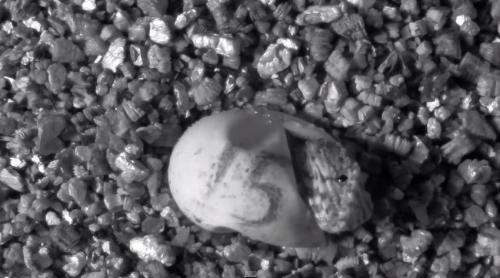Rare footage captured of tuatara hatching (w/ Video)

Extremely rare footage of a tuatara hatching has been filmed at Victoria University of Wellington. Last to hatch, the egg was one of 23 being incubated in captivity this year as part of a joint initiative that helped to save a threatened population of tuatara from extinction.
Since the early 1990s, Victoria University, the Department of Conservation (DoC) and local Mana Whenua Ngati Manuhiri have run an intensive conservation recovery plan for tuatara on Hauturu ō Toi/Little Barrier Island, partly-funded by The Hauturu Supporters Trust and Auckland Zoo.
Hauturu ō Toi is a nature reserve located 80 kilometres north-east of Auckland, which is now home to around 300 tuatara, most of which have been incubated at Victoria University.
The tuatara filmed was an offspring from the programme. Using a low-cost microcomputer and infrared camera, Warren Butcher from Victoria University's Image Services team filmed seven hours of footage and then compressed it into a short video clip.
Warren worked with Sue Keall, a technician in Victoria's School of Biological Sciences and the Allan Wilson Centre for Molecular Ecology and Evolution, one of New Zealand's eight Centres of Research Excellence, who was a volunteer in the first team to visit Hauturu ō Toi 23 years ago. The team searched day and night for tuatara, which are found only in New Zealand, and which had not been seen on the island for 10 years.
Professor Charles Daugherty, Assistant Vice-Chancellor (Research) at Victoria, led the conservation initiative as part of a wider joint Victoria and DoC study of the 30 known tuatara populations, all on islands around New Zealand.
The Hauturu ō Toi/Little Barrier population was of special interest, says Professor Daugherty, as it occupied by far the largest island on which tuatara had possibly survived, and was the only island with kauri forest and other habitats common on mainland New Zealand. However, no tuatara had been seen on the island since 1981, and the population was believed to be extinct.
Dr Nicky Nelson, an associate professor in Victoria's School of Biological Sciences and Principal Investigator with the Allan Wilson Centre, joined a second trip where the teams found four more tuatara. Shortly after, a purpose built 'tuatarium' enclosure was built to house the four male and four female tuatara.
Over the years, the tuatara laid eggs that were sent to Victoria University to be incubated and hatched. The young tuatara were then returned to Hauturu ō Toi/Little Barrier to be reared in a 'headstart' programme, where they were kept in special enclosures, safe from kiore.
Since kiore were eradicated from the island in 2006, juvenile tuatara hatched at Victoria have been able to be released into the wild on Hauturu ō Toi/Little Barrier Island.
"For the Little Barrier population, this programme stopped their near certain extinction in the presence of kiore, and boosted their recovery by increasing the numbers more quickly than could have happened naturally," says Ms Keall.
The tuatara caught on video is the 255th to be hatched at Victoria as part of the programme.
Provided by Victoria University of Wellington


















